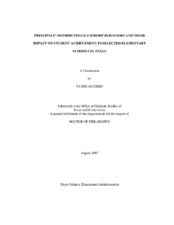| dc.description.abstract | Educators are frequently faced with the challenges of politics, hostility, selfishness,
and violence; it is unwise to think that the principal is the only one providing leadership
for school improvement. Thus a distributed perspective of leadership urges us to take
leadership practice as the focus of interest and address both teachers and administrators
as leaders.
The purpose of this descriptive statistical study was to explore principals’
leadership practices as perceived by teacher leaders and its possible affect to student
achievement. Data were collected by using the Leadership Practices Inventory (LPI)
(self and observer) instrument (Kouzes & Posner, 2003) from all willing teacher leaders
to determine the leadership practices of the principals in Region VI, Texas. Also,
statewide assessment data available from three school years (2004-2006) were obtained
from the Academic Excellence Indicator System (AEIS) report. In order to answer
research questions one to four, descriptive statistics including frequency, percentage,
mean and standard deviation were calculated for the LPI results.
The distributed framework offers considerable influence for studying leadership as a schoolwide rather than individual practice. Based on the literature, six conclusions
were drawn and recommendations were made regarding practice, future study and policy.
First, the findings indicated that principals’ collaborative working style with teacher
leaders seems to have positive impact on student achievement. Second, failing to enlist
teacher leaders in a common vision might have a negative affect on student academic
performance. Third, the perceptions of teacher leaders in School 7, School 5 and School
16 reflected a need for the principal to take challenges and seek challenging
opportunities to change and grow. Fourth, recognizing teacher leaders’ contributions and
celebrating team accomplishments is likely to have a positive and indirect impact on
school academic performance. Fifth, schools that had higher principal self and observer
LPI scores tended to have better TAKS scores. Last, the findings from the study
complement studies of the effects of site-based management teams. The positive impact
of “Enabling Others to Act” and “Inspiring a Shared Vision” on student achievement
implies that distributed leadership is most likely to contribute to school improvement
and to build school capacity for improvement. | en |


